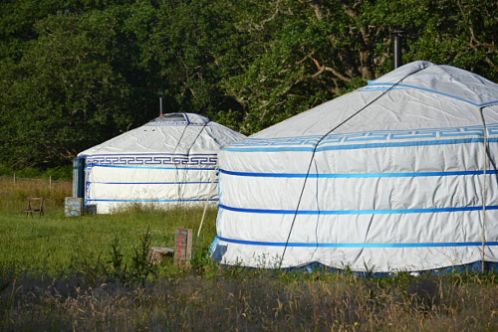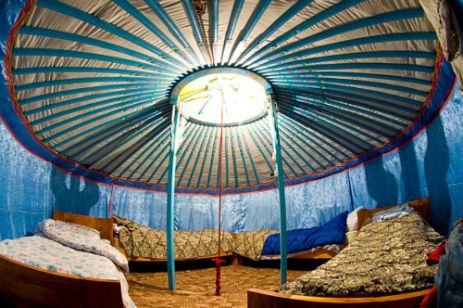Canvas yurts
Because canvas is regarded as one of the toughest materials for yurts, it may be somewhat more costly in certain situations. You may even come across yurts that are constructed of canvas and cotton, or even canvas cotton. These will all be high-end and sought after items, so you can feel safe purchasing any of them.
Polyester Yurts
Polyester is more of a less expensive option for yurts, so if you are on more of a budget and need to get it cheaper, this may be the way to go.
Spelt Yurts
Spelt being one step down from polyester means that they will also come at an affordable price but won’t sacrifice any quality. They are still very durable and can handle many different kinds of weather conditions without getting damaged or worn out. Spelt use only results in making products even better over time with continued usage which actually makes them last longer than most other options available today.
Thatch Yurt
Although not as popular, there are also some people who opt for using straw instead when constructing their yurts because it is much cheaper. However, it may not be the most well-liked option because straw takes in water very easily so if you are in a wet climate this could cause your yurt to collapse over time due to rusting nails and other materials which have been used in its construction.
Bamboo Yurt
More recently, bamboo has been used to construct yurts because it is so strong and durable. In fact, many people have found that they can even use bamboo when constructing a yurt for the poles instead of wood which gives them more support than ever before.

The Modern Yurt
Nowadays you will find most modern yurts being made from steel or aluminium in order to give them increased strength and durability over time. They may also come with extra insulation depending on your climate conditions in order to make sure that you get maximum results out of each purchase while keeping everything as safe and secure as possible at all times too.
Wooden yurts
Wooden yurts are very popular because they are lightweight, easy to transport and set up. They can be painted in various colours depending on the preference of the owner but typically come with lighter paint jobs than other types.
Types of yurts according to size and shape
Bell-Shaped Yurts
The bell-shaped yurt is known to be the oldest type of yurt, its design has changed very little over time. These are generally used for nomadic living and thus they are portable enough to carry from place to place.
Conical Yurts
These types look like a cone with a flat top that tapers down towards the bottom. They are typically used as a permanent structure and generally have more space inside than the bell-shaped yurts which keep them from being very portable.
These types of yurts usually come with an aluminium frame, making them easier to move around but less likely to withstand harsh weather conditions compared to other types of tents.
Mongolian Yurt
The Mongolian yurt is the most popular type of yurt. It typically has a wooden frame, lattice walls covered with sheets of felt, and a collapsible trellis roof system that is supported by central poles at the top and bottom. The door always faces south to benefit from sunlight throughout much of the day. These are often the yurts that are used for festivals and by tourists.
There are two types of Mongolian yurts.
Traditional Mongolian yurts are built to be permanent homes for Mongolians. Some people in other countries have begun using these long-lasting yurts as guest homes on their land. They provide an excellent way to add an extra living area for individuals while also adding a unique charm to the space.
Commercially marketed Mongolian yurts that are built similarly to these natural huts but are more frequently utilized for leisure and camping. People in countries like the United States have taken a liking to these yurts because of their beauty and for how well they function as camping tents.
Yurt Festival Tent
Yurt festival tents are often used for temporary purposes. They can be taken down and reassembled as many times as needed without the fear of damage to the fabric because they are not built with straw or wooden materials that would be damaged by continuous reuse. Festival yurts may have either a solid roof, which is more suitable for warm weather or one that has a cut-out design on the top, which is better for colder weather.
Family-Sized Yurt
Family-sized yurts are generally built with wooden materials and have a door at each end, allowing more than one family to occupy the same space. This type of yurt is large enough for several people to sleep in while also providing additional living spaces like kitchens or laundry rooms that can be used by any occupants. These types of tents are often used for festivals, community events, and other similar occasions.
Children’s Yurt for Play
Children’s yurts are smaller versions of the traditional Mongolian tent that can be used for playtime. These types of tents often stand no more than four feet tall and some may even include a doorway with an arched top to add extra charm while also helping to keep water out when it rains. They provide children with fun places to play and explore while also allowing them to feel as though they are in another world.
These tents can be used outside for picnics, trips to the beach or lake, camping excursions with friends and family, or even during playdates at a friend’s house. They may not have all of the amenities that some other living spaces have, but they are also easy to clean and maintain. Similarly, sized tents can be used indoors for playtime activities or as a quiet space that is completely contained within the home.
Portable Yurt

A portable yurt is a tent that can be easily assembled and disassembled without any tools. They are often made of materials like PVC, canvas fabric, or nylon so they do not need to be treated with oil before storage and transportation. These types of tents may come in several different sizes depending on the buyer’s requirements for space and portability.
In addition to their ease of assembly and transportation, the other benefit that comes with these types of yurts is they are relatively affordable when compared to Mongolian tents. They may not have all of the same benefits like insulation or protection from wet weather conditions, but for people who do not need any additional amenities in their living space, they are perfect.
Portable yurts can be used for several different purposes including camping, tailgating parties at sporting events or concerts, overnight guests when there is not enough room in the home to provide them with their own space, or even as a quiet place where people can go to get away from it all and enjoy nature without having to leave the comforts of home.
Bentwood yurts
Another type of yurt is not commercially available in the United States. They were originally created by American hippies who wanted to return to a simpler way of life. These types of tents have wooden frames and all parts may be made with either natural or stained wood depending on their intended use. Some bentwood yurts may also include metal or plastic components.
Bentwood yurts are aesthetically appealing, relatively lightweight, and very affordable when compared to other types of Mongolian tents. The downside is they can be difficult to transport once the materials have been cut down into smaller pieces that must then be assembled together at their destination or before storage for future use. As with any yurt, bentwood yurts may be used for a variety of purposes including camping in remote locations with no electricity or access to fresh water.
8-Person Yurt
Another type of yurt is one that can be used for a group of people instead of just an individual or family. These types of tents are often made from large pieces of fabric that have been sewn together in the middle to create a dome shape with straight sides and no rounded edges.
In addition to providing more space, these larger Mongolian tents may also come equipped with doors on every side so they can accommodate up to eight occupants at any given time. This allows them to function as either temporary housing when there is not enough room inside a home or apartment building, but it also means they will need additional insulation during cold weather months because they lack walls like other living spaces do. They may even include two layers if their owners want to be extra safe from the elements.
Even though they are not as portable and may require more storage space, many people who live in these types of yurts will tell you that it is well worth the trade-off for all of the benefits like affordability, simplicity, comfortability (sic), and connection to nature that come with living in such a unique place.
An Interior Yurt

Interior yurts are much like stationary gers, but they can be built to stay in one place instead of being moved around as nomads would traditionally do. These types tend to have a circular floor plan and usually include an open centre which is used for firewood storage along with other materials that need protection from the elements due to their very nature or high value (such as food). They also don’t come equipped with smoke holes so people won’t feel too overwhelmed by fumes when using them without proper ventilation systems installed inside!
